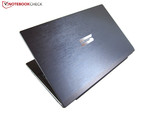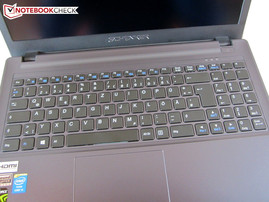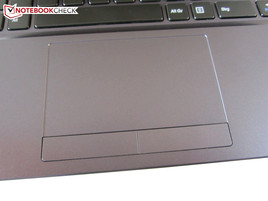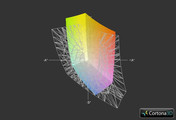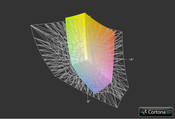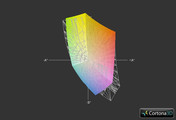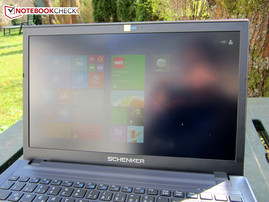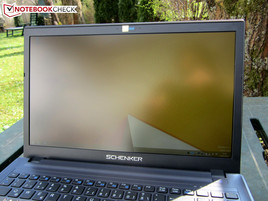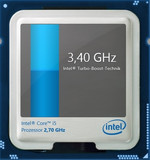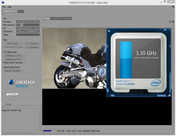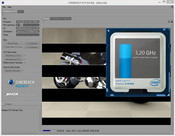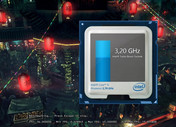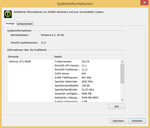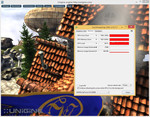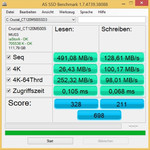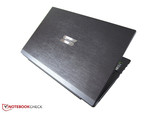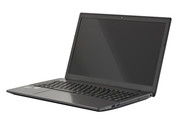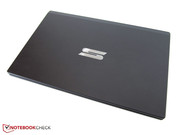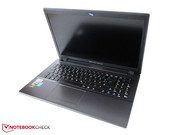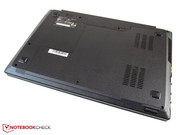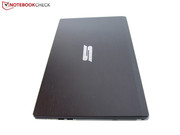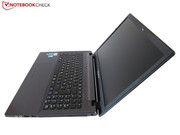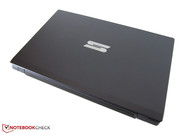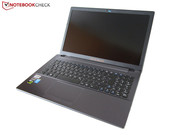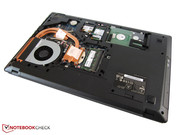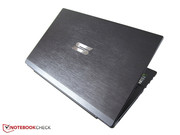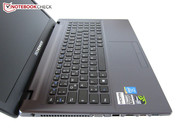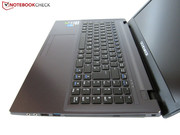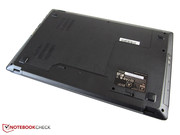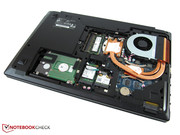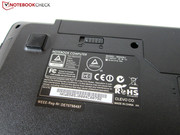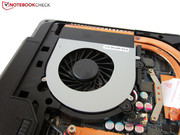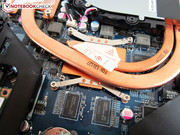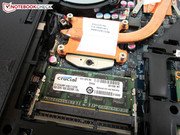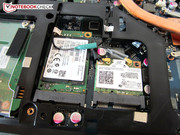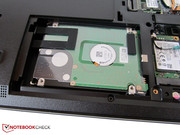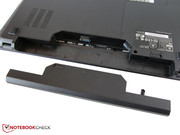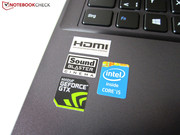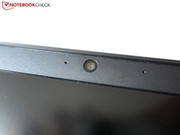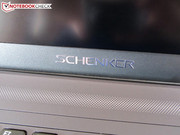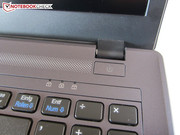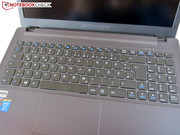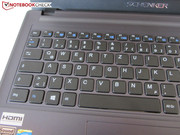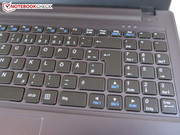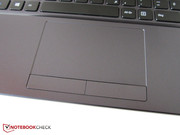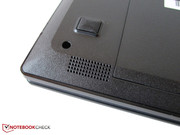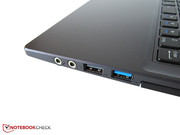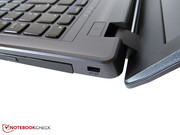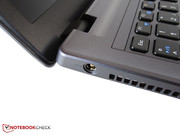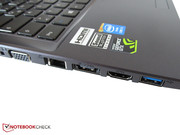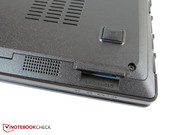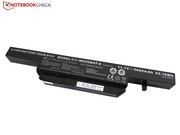Review Clevo W650SJ (Schenker M504) Barebones Notebook
For the original German review, see here.
After we already reviewed the GeForce GTX 880M (Schenker XMG P704), the GTX 870M (One K73-4N) and the GTX 860M (Schenker XMG P304 and A504), we now have a closer look at the last high-end GPU from Nvidia's brand-new GPU generation: The GeForce GTX 850M. The DirectX 11 model is supposed to offer the best compromise of performance, heat and power consumption. Basis is the promising Maxwell architecture.
But the all-round notebook also offers a lot besides the performance. Biggest unique feature in our opinion is the matte Full HD display. While most notebooks are usually equipped with an inexpensive TN panel, the M504 uses the IPS technology with wide viewing angles.
You should replace the processor (Pentium 3550M) of the base configuration if possible. Thanks to the high performance, the GeForce GTX 850M can actually benefit from faster CPUs. If you can live with the shorter battery runtimes and the increased heat, you can also select a CPU from the i7-series, for example the Core i7-4702MQ (TDP of 37 Watts) or i7-4700MQ (TDP of 47 Watts). We would not recommend even faster processors, occasional gamers on the other hand can also get a dual-core from the i5-series.
Besides the processor, you can also configure other components on the homepage mysn.co.uk. It starts with the memory equipment from four all the way up to 16 GB (two slots). Furthermore, the notebook has a 2.5-inch drive bay as well as a slot for mSATA SSDs. Finally you can select different wireless adaptors, keyboards and optical drives. Nowadays, the operating system is also standard (Windows 8.1 64-bit).
Depending on the hardware, the M504 can cost between 850 and 2,500 Euros. A balanced configuration, which is also used for our review unit, retails for around 1,000 to 1,500 Euros.
Case
We already mentioned that the chassis design of the 15-inch notebook not really reminds us of a powerful multimedia or gaming notebook, it actually looks more like an inexpensive notebook for the office or the university. Only the glossy »S« at the display cover attracts some attention.
Schenker uses the W650SJ barebone from Clevo for the M504, which shares many features with the old W650SR. Due to the similiarities we will just have a brief look at the case, the connectivity, the keyboard as well as the touchpad. More information can be found in the review of the One K56-3F.
But back to topic: Barebone manufacturer Clevo does not use aluminum, so the notebook does not really leave a high-quality impression and just feels pretty average. The matte finish and the silver color at least do not really attract dirt. Because of the comparatively thin chassis (~3.5 centimeters including supporting feet), the case does lack some stability. Especially around the optical drive, where the surface, similar to many rivals, can be pushed in. We would have preferred a higher stability in this area, and the same applies for the display cover.
We are also not completely convinced by the hinges. Despite the pretty firm mechanics (the base unit moves when we open the lid), the display wobbles during vibrations. Overall the case quality is (still) decent.
Connectivity
Ports
The port variety meets the usual multimedia standard. One analog and one digital video port are available, just like two stereo jacks and a Gigabit-Ethernet port. Furthermore, you get an USB 2.0 port, two USB 3.0 ports and an eSATA/USB 3.0 combination. The notebook can be secured against theft via Kensington Lock.
Using a mouse on the left or right side of the case reveals the unfavorable port layout. Many ports are far at the front, so many attached cables can create unwanted collisions.
Other Clevo barebones like the P150SM or the W355SS offer a more sophisticated port layout. It is also not ideal that the fan exhaust is next to the WASD keys (temperature, inconvenient air flow for left-handers...).
Wireless Communication
Considering the moderate additional charges, it is not easy to choose the suitable wireless adaptor. Schenker equips our review unit with the Wireless-AC 3160, which does not only support the standards 802.11 b/g/n, but also the latest ac technology.
According to Intel, the maximum transfer rate is 433 Mbps and you can use 2.4 and 5 GHz networks. The module is passable in terms of range, we still had 1-3 bars with a distance of 10-15 meters to the router and through several walls.
Maintenance
It can be so easy: Grab a tool, loosen two screws, remove the maintenance cover and you get full access to the components: Hard drive, memory and wireless module. The heat from the CPU (changeable) and GPU (soldered onto the mainboard) is dissipated via heat pipe directly to the fan. Every mentioned component can be removed.
Software
Schenker is synonymous with a clean Windows installation without annoying bloat ware that could slow down the system.
Accessories
The scope of supply is pretty unspectacular if you do not order an operating system. Besides the 6-cell battery with a weight of 326 grams and a 120 Watts power adaptor (148 x 74 x 26 millimeters), you only get a quick start guide, a driver DVD and a DVD with Nero 12 Essentials.
Warranty
The warranty period is either 24 months (Base), 36 months (Premium) or 48 months (Platinum). Schenker promises a Pickup & Return Service for this period. The time interval of the Instant Repair depends on the according warranty package.
Input Devices
Keyboard
The matte black chiclet keyboard cannot really convince us. While the layout and the typing experience are decent, there is still room for improvement in terms of typing noise. It sounds pretty rickety at some spots (for example in the area of the arrow keys) and therefore feels quite cheap. The feedback of the space bar is – typical for Clevo – also not perfect. Especially the missing illumination is annoying, you will have to use an additional light in darker environments.
Otherwise the keyboard leaves a good impression. The clear lettering and the handy special functions (you can, for instance, control the touchpad, the sound, the display, the webcam and the wireless module via F-row) enable a convenient operation. A spacing of three millimeters improves the handling as well.
Touchpad
A touchpad size of 107 x 62 millimeters is unusually large for a 15-inch notebook. Even though the precision and the gliding capabilities are not on a reference level, you do not necessarily have to use an external mouse in practice.
Schenker did not install drivers on our review unit, so the notebook did not recognize gestures, but the multitouch support of the One K56-3F was excellent. Clevo should definitely improve the mouse buttons; they are beneath the touchpad and tend to tilt to the sides.
Display
What do a Solid State Drive and an IPS panel have in common? Correct, you do not want to miss the according technology once you have experienced it in practice. This also applies for the M504. Inexpensive TN panels, which are used in many notebooks, do not stand a chance in a direct comparison. The biggest advantage is the high color intensity. It does not matter if you look at pictures, videos or games: Any content is immensely rich and natural.
The available color space of the LG Philips LP156WF4-SPB1 panel (also used in the Acer Aspire V3-571G) cannot really enthrall us with 72 % sRGB and 50 % AdobeRGB, but the professional software CalMAN does show a decent color accuracy and RGB balance (see screenshots). »Standard« panels like the Chi Mei N173HG in the One K73-4N often show higher deviations.
| |||||||||||||||||||||||||
Brightness Distribution: 90 %
Center on Battery: 307 cd/m²
Contrast: 930:1 (Black: 0.33 cd/m²)
ΔE ColorChecker Calman: 6.98 | ∀{0.5-29.43 Ø4.78}
ΔE Greyscale Calman: 6.63 | ∀{0.09-98 Ø5}
50% AdobeRGB 1998 (Argyll 1.6.3 3D)
51.1% AdobeRGB 1998 (Argyll 3D)
69.1% sRGB (Argyll 3D)
52.8% Display P3 (Argyll 3D)
Gamma: 2.46
CCT: 6471 K
The M504 also does a good job apart from the color presentation. The IPS display shows excellent results for the black value (0.3 cd/m²) and the contrast ratio (900:1). A brightness distribution of 90 % and a luminance of 296 cd/m² are respectable as well.
Users will have to live with some restrictions in regard to the outdoor use. The display surface is not as matte as many other anti-reflective rivals.
Probably the biggest highlight of the IPS technology is the excellent viewing angle stability. Contrary to TN panels you can also look at the display from a vertical angle without huge picture deviations, only views from above at an angle will reveal some small distortions.
Interestingly, the predecessor was equipped with another IPS type. The LG Philips LP156WF4-SLB5 does have a 20 % higher luminance and slightly better CalMAN results, but the black value and the contrast cannot quite keep up. Color space coverage and viewing angles on the other hand are basically identical.
Performance
Processor
Besides several quad-core CPUs, the configurator also includes a number of dual-core models. The Core i5-4310M of our review unit is a mainstream processor of the current Haswell generation with an additional charge of 113 Euros.
While the manufacturing process of all models is identical (22 nm), the other specifications can differ significantly. For example the L3 cache, which is – depending on the processor – between two and eight MB. The thermal design power, which indicates the required cooling performance – differs as well. Contrary to most quad-cores, the dual-cores have a specified TDP of 37 Watts that indicates a lower heat production and a lower power consumption.
Except for the Pentium 3550M, all processors can double the number of threads via Hyperthreading. The automatic overclocking via Turbo Boost is only supported by the Core i5 and i7-series; the Core i5-4310M can run with up to 3.4 GHz under load.
As it should be for a notebook from 2014, the M504 does support switchable graphics. Nvidia's Optimus technology works automatically and – if the database is kept up to date – very accurately.
Turbo Boost
We use Cinebench R10 and Hitman: Absolution to test the Turbo Boost of the Core i5-4310M. Even though the clock occasionally dropped to 3.0 GHz, we determined an average of 3.3-3.4 GHz (single-core load) and 3.2-3.3 GHz (multi-core load), respectively. A higher clock is hardly realistic for this processor.
CPU Performance
The Core i5-4310M can keep up pretty well with its more expensive siblings as long as you just stress one core. Cinebench R15 determines 128 points, which is right between the Core i7-4702MQ (124 points @MSI GE40) and the Core i7-4700MQ (132 points @Gigabyte P25W). The smaller sibling Core i5-4200M is around 8 % slower (118 points @Lenovo IdeaPad Z510). You should not select an i3 CPU because of the missing Turbo Boost; a Core i3-4000M not even manages 100 points (95 @Lenovo ThinkPad Edge E540).
All dual-cores look pretty bad in the Multi-CPU test. It does not matter if it is a Core i3-4000M (240 points @HP ProBook 650 G1), Core i5-4200M (298 points @HP Envy 15-j011sg) or Core i5-4310M (325 points): The results are not even close to the i7-series. According to our benchmark, the Core i7-4702MQ has an advantage of around 80 % (581 points @HP ProBook 450 G1) over our review unit, whereas the Core i7-4700MQ is around 100 % faster (642 points @Lenovo IdeaPad Y510p).
| Cinebench R11.5 | |
| CPU Single 64Bit (sort by value) | |
| Core i5-4310M | |
| Core i3-4000M | |
| Core i5-4200M | |
| Core i7-4702MQ | |
| Core i7-4700MQ | |
| CPU Multi 64Bit (sort by value) | |
| Core i5-4310M | |
| Core i3-4000M | |
| Core i5-4200M | |
| Core i7-4702MQ | |
| Core i7-4700MQ | |
Graphics
Contrary to the GTX 880M and GTX 870M, the GeForce GTX 850M is based on Nvidia's latest Maxwell architecture, which is once again produced in a 28 nm process.
640 Unified Shaders are clearly superior to the predecessor GT 750M (384 CUDA-Cores) and identical to the GTX 860M. Main difference is the integrated video memory. While the GTX 860 only uses GDDR5, there is also a DDR3 version of the GTX 850M. The amount of memory is decent with 2,048 MB, but a combination of DDR3-VRAM and a 128-bit interface is not up to date anymore.
Thanks to the architectural improvements, the DirectX 11 chip is still pretty close to the high-end competition. One reason for that are the high clocks. According to the tool GPU-Z, the core can run with up to 1084 MHz under load. We used the preloaded GPU driver (ForceWare 332.35).
GPU Performance
The benchmark results are surprisingly high for a graphics card with DDR3 video memory. 3DMark 13 Fire Strike determines a GPU score of 3,086 points for the M504. Both the GTX 765M (2,768 points @Schenker XMG A503) as well as the DDR3 version of the GT 750M (1,589 points @HP Envy 17-j110eg) clearly fall behind in this test. We can only see the negative impact of the memory in comparison with the GTX 860M. The latter is around 30 % faster in the Fire Strike test (3,936 points @Schenker XMG A504).
We can see a similar situation in the Unigine Heaven 3.0 benchmark (1920x1080, Tessellation normal). The GTX 850 manages 40.2 fps on average and is 12 % ahead of the GTX 765M (36.0 fps @Schenker W503), but also 19 % behind the GTX 860M (49.6 fps @Schenker XMG P304). The Maxwell chip can easily beat the old GT 750M by around 80 % (22.3 fps @One K56-3F).
| 3DMark 11 - 1280x720 Performance GPU (sort by value) | |
| GeForce GTX 850M DDR3 (332.35) | |
| GeForce GT 750M DDR3 (311.54) | |
| GeForce GTX 765M (311.54) | |
| GeForce GTX 860M (332.60) | |
| 3DMark Vantage - 1280x1024 P GPU no PhysX (sort by value) | |
| GeForce GTX 850M DDR3 (332.35) | |
| GeForce GT 750M DDR3 (311.54) | |
| GeForce GTX 765M (311.54) | |
| GeForce GTX 860M (332.60) | |
| 3DMark Vantage P Result | 13226 points | |
| 3DMark 11 Performance | 4270 points | |
| 3DMark Ice Storm Standard Score | 78759 points | |
| 3DMark Cloud Gate Standard Score | 9764 points | |
| 3DMark Fire Strike Score | 2695 points | |
Help | ||
Storage Devices
Price-conscious users who want a snappy system AND a lot of storage should get a combination of mSATA SSD and HDD. Schenker integrated the 120 GB version of the Crucial M500 (CT120M500SSD3) to limit the price of our review unit.
mSATA format or not: A sequential write speed of 129 MB/s is not really fast by todays standards. Besides the Samsung 840 Evo, the Intel 530 should be quicker as well, even though the according SSDs have an additional charge of more than 20 Euros. The reading performance on the other hand does not cause any criticism: Up to 491 MB/s meet the requirements of a SATA-III drive. Access times of 0.11 and 0.07 ms (read/write) are not bad, either.
The 2.5-inch bay is equipped with the standard HDD of the configurator. Seagate's Momentus ST500LM012 is a 500 GB drive with 5,400 revolutions per minute. The performance of the hard drive is decent, which is supported by up to 90 MB/s in CrsytalDiskMark. Larger rivals like the HGST Travelstar 5K1500 (Schenker XMG A504) usually manage more than 100 MB/s.
System Performance
The mediocre performance of the SSD prevents a higher score in the system benchmarks. PCMark 7 determines 4,969 points for the M504, which is right between the compact 15-inch gaming notebooks Asus N56JR (i7-4700HQ, GeForce GTX 760M, TB HDD) and Gigabyte P25W (Core i7-4700MQ, GeForce GTX 770M, SSD RAID) with 3,371 and 5,840 points, respectively. MSI's GE60H (5,587 points @ Core i7-4700MQ, GeForce GTX 765M & SSD RAID) also has an advantage over our review unit.
| PCMark 7 Score | 4969 points | |
| PCMark 8 Home Score Accelerated v2 | 3198 points | |
| PCMark 8 Creative Score Accelerated v2 | 4543 points | |
| PCMark 8 Work Score Accelerated v2 | 4024 points | |
Help | ||
Gaming Performance
Depending on the game we can see mixed results from the GTX 850M. Ambitious gamers, who want to play every title in 1920x1080, maximum details and high anti-aliasing settings, should look for another device. As expected, the 28 nm model in the M504 is not powerful enough for these scenarios.
The system is however fast enough for 1600x900 pixels and high details and even provides very good graphics in GPU demanding titles like Battlefield 4, Metro: Last Light or Far Cry 3. Considering the chip size, the performance is surprisingly high.
We can only see a negative impact of the dual-core processor in a few titles and you can only see some differences to quad-core systems when you reduce the details.
All in all the GeForce GTX 850M is a powerful DirectX 11 GPU, which is on one level with the GTX 765M and around 80 % ahead of the DDR3 version of the GT 750M. Such a high performance increase is unusual for a new generation. Passionate gamers on the other hand should at least choose a GTX 860M (+40 %).
| low | med. | high | ultra | |
|---|---|---|---|---|
| Guild Wars 2 (2012) | 84.3 | 44.3 | 24.5 | |
| Hitman: Absolution (2012) | 48.8 | 44.6 | 34.9 | 14.2 |
| Far Cry 3 (2012) | 76.2 | 69.4 | 47.2 | 16.2 |
| Crysis 3 (2013) | 80.3 | 47.4 | 34.4 | 13.1 |
| Tomb Raider (2013) | 202 | 127.5 | 65.4 | 31.6 |
| BioShock Infinite (2013) | 138.4 | 95.2 | 81.7 | 27.6 |
| Metro: Last Light (2013) | 56.1 | 53.9 | 40.7 | 21.5 |
| GRID 2 (2013) | 110 | 83.8 | 77.5 | 36.6 |
| Dota 2 (2013) | 110.2 | 88 | 65.2 | |
| Saints Row IV (2013) | 54.9 | 48.5 | 36 | 22.7 |
| F1 2013 (2013) | 112 | 93 | 85 | 66 |
| Battlefield 4 (2013) | 100.7 | 81.1 | 55.4 | 20.4 |
| Call of Duty: Ghosts (2013) | 71.1 | 67 | 39.2 | 20.8 |
| X-Plane 10.25 (2013) | 79.9 | 39 | 22 | 15.1 |
| Thief (2014) | 45.4 | 39.6 | 35.7 | 18 |
| Titanfall (2014) | 60 | 59.7 | 48.8 | 35.4 |
Emissions
System Noise
Clevo experts will be eager to see the noise development. In short: There’s good and bad news. The M504 is still pretty restrained during Windows when the Nvidia GPU is deactivated. 31-32 dB(A) are not even disturbing for sensitive users, especially because the fan and the HDD are occasionally deactivated, which results in a silent notebook.
Our review unit did, however, have some issues with a slight clattering noise. We do not know this problem from our long-term loaned device M503. Isolated incident or general problem? We are not sure yet. Annoying is also the temporarily rpm increase, even simple tasks like Office or web browsing can result in an unnecessary increase of the fan speed. This sudden pulsating is already familiar from other Clevo notebooks. It appears as if there is no fan setting between those two rpm levels.
Main problem is still the noise during GPU demanding applications. An average result of 47 dB(A) during 3DMark 06 is – despite the similarly powerful hardware – beaten by the MSI GE60H (~45 dB(A)), the Gigabyte P25W (~40 dB(A)) and the Asus N56JR (~39 dB(A)). Schenker’s own XMG A504 is quieter in this scenario as well with ~44 dB(A). The cooling solution is therefore clearly audible during gaming without a headset or loud ambient noises. The fan does at least slow down pretty quickly after a load period.
Noise level
| Idle |
| 29.5 / 31 / 31.8 dB(A) |
| DVD |
| 35.2 / dB(A) |
| Load |
| 47.4 / 53 dB(A) |
 | ||
30 dB silent 40 dB(A) audible 50 dB(A) loud |
||
min: | ||
Temperature
The situation is much better in regard to the temperatures. After our 60-minute stress test with the tools FurMark and Prime, we just determined a maximum surface temperature of 39 °C (top) and 41 °C (bottom), respectively.
The components did not get really hot, either. Around 80 °C for the processor and 68 °C for the GPU are more than acceptable and show that the fan control is too aggressive. Only the temperature of the mSATA SSD is pretty high; according to the CPUID hardware monitor, the Solid State Drive can reach up to 64 °C in this extreme scenario.
Another area that could be improved is the palm rest. 29-34 °C during idle are not perfect for sensitive users, and the hands can warm up when you write longer texts. Overall, however, the temperatures are reasonable.
(+) The maximum temperature on the upper side is 39.4 °C / 103 F, compared to the average of 36.9 °C / 98 F, ranging from 21.1 to 71 °C for the class Multimedia.
(±) The bottom heats up to a maximum of 41.2 °C / 106 F, compared to the average of 39.2 °C / 103 F
(±) In idle usage, the average temperature for the upper side is 32 °C / 90 F, compared to the device average of 31.3 °C / 88 F.
(±) The palmrests and touchpad can get very hot to the touch with a maximum of 39.1 °C / 102.4 F.
(-) The average temperature of the palmrest area of similar devices was 28.7 °C / 83.7 F (-10.4 °C / -18.7 F).
Speakers
The two speakers (front of the case) are not very good. Yes, the SBX Pro Studio technology of the Sound Blaster Cinema software does improve the power and volume of the device.
But we cannot say that the resulting sound is good. Typical for notebooks is the pretty tinny, muffled and imprecise playback of audio files. This is especially evident during music playback and cannot be compensated by the decent maximum volume, either. Both the Asus N550/N56 and the HP Envy 15 sound much better.
Therefore, we recommend the use of external speakers or headphones, but the sound quality is sufficient as a temporary solution. Compared to the rivals it is on an average level.
Energy Management
Power Consumption
We want to compare the power consumption with the XMG A503, which was also equipped with a dual-core and a TDP of 37 Watts. It is evident that the Maxwell architecture is more efficient. Instead of 88-124 Watts, the M504 only consumes 73-106 Watts during 3D operation. That is an improvement of around 20 %, and the GTX 850M is not even slower than the GTX 765M. This trend continues during idle; 11-17 Watts are clearly surpassed by the XMG A503 (15-25 Watts).
| Off / Standby | |
| Idle | |
| Load |
|
Key:
min: | |
Battery Runtime
Thanks to the moderate power consumption, the M504 does manage decent battery runtimes. Despite the smaller battery (62 vs. 77 Wh) it does not have to hide behind the high-end devices from the A- and P-series.
You can manage more than five hours during idle when you optimize the energy settings (minimum display brightness etc.). More than four hours of web browsing with 50 % brightness and 3.5 hours DVD playback with the maximum brightness are not bad, either. The Battery Eater Classic test, which simulates maximum load for the system, determines a runtime of around 2.5 hours. Most notebooks only manage around 1.5-2 hours (e. g. XMG A504)
Great: The 3D performance is only reduced by around 5 % on battery power.
Verdict
Contrary to many rivals, the Schenker M504 is no boxy gaming device with a limited mobility. Thanks to the thin construction, the comparatively low weight (~2.5 kg) and the good battery runtimes it is a very mobile notebook. Case manufacturer Clevo does not risk anything in regard to the case design, so the 15-inch notebook cannot only be used on your desk at home but also in situations that require understatement.
The same would apply for the fan if there was a better fan control. We have to criticize the very loud noise during 3D operation in the current state. The manufacturer should also improve the port layout, the sound quality and the case stability. A non-illuminated keyboard with some clattering issues is not very convenient, either.
The anti-reflective IPS display on the other hand is a key argument for the purchase. Brightness, black value, contrast and color intensity are very good. Other positive aspects are the large touchpad and the comfortable maintainability. Combined with the Maxwell GPU you get a powerful and attractively priced package, but it is not a perfect all-rounder.
In Comparison
| Titanfall - 1920x1080 (Very) High AA:4xMS AF:16x (sort by value) | |
| GeForce GTX 850M DDR3 (332.35) | |
| GeForce GT 750M DDR3 (mixed driver) | |
| GeForce GTX 765M (mixed driver) | |
| GeForce GTX 860M (332.35) | |
| Thief - 1920x1080 Very High Preset AA:FXAA & High SS AF:8x (sort by value) | |
| GeForce GTX 850M DDR3 (332.35) | |
| GeForce GT 750M DDR3 (mixed driver) | |
| GeForce GTX 765M (mixed driver) | |
| GeForce GTX 860M (332.35) | |
| X-Plane 10.25 - 1920x1080 ultra (fps_test=4) test_flight_c4 (sort by value) | |
| GeForce GTX 850M DDR3 (332.35) | |
| GeForce GT 750M DDR3 (mixed driver) | |
| GeForce GTX 765M (mixed driver) | |
| GeForce GTX 860M (332.35) | |
| Call of Duty: Ghosts - 1920x1080 Extra / High / HBAO+ / No dynamic fur AA:4x MS (sort by value) | |
| GeForce GTX 850M DDR3 (332.35) | |
| GeForce GT 750M DDR3 (mixed driver) | |
| GeForce GTX 765M (mixed driver) | |
| GeForce GTX 860M (332.35) | |
| Battlefield 4 - 1920x1080 Ultra Preset AA:4x MS (sort by value) | |
| GeForce GTX 850M DDR3 (332.35) | |
| GeForce GT 750M DDR3 (mixed driver) | |
| GeForce GTX 765M (mixed driver) | |
| GeForce GTX 860M (332.35) | |
| F1 2013 - 1920x1080 Ultra Preset AA:4x MS (sort by value) | |
| GeForce GTX 850M DDR3 (332.35) | |
| GeForce GT 750M DDR3 (mixed driver) | |
| GeForce GTX 765M (mixed driver) | |
| GeForce GTX 860M (332.35) | |
| Saints Row IV - 1920x1080 Ultra Preset AA:8x MS AF:16x (sort by value) | |
| GeForce GTX 850M DDR3 (332.35) | |
| GeForce GT 750M DDR3 (mixed driver) | |
| GeForce GTX 765M (mixed driver) | |
| GeForce GTX 860M (332.35) | |
| Dota 2 - 1920x1080 High / On, Render Quality: 100 % (sort by value) | |
| GeForce GTX 850M DDR3 (332.35) | |
| GeForce GT 750M DDR3 (mixed driver) | |
| GeForce GTX 765M (mixed driver) | |
| GeForce GTX 860M (332.35) | |
| GRID 2 - 1920x1080 Ultra Preset AA:4xMS (sort by value) | |
| GeForce GTX 850M DDR3 (332.35) | |
| GeForce GT 750M DDR3 (311.27) | |
| GeForce GTX 860M (332.35) | |
| Metro: Last Light - 1920x1080 Very High (DX11) AF:16x (sort by value) | |
| GeForce GTX 850M DDR3 (332.35) | |
| GeForce GT 750M DDR3 (311.27) | |
| GeForce GTX 860M (332.35) | |
| BioShock Infinite - 1920x1080 Ultra Preset, DX11 (DDOF) (sort by value) | |
| GeForce GTX 850M DDR3 (332.35) | |
| GeForce GT 750M DDR3 (311.27) | |
| GeForce GTX 765M (311.27) | |
| GeForce GTX 860M (332.35) | |
| Tomb Raider - 1920x1080 Ultra Preset AA:FX AF:16x (sort by value) | |
| GeForce GTX 850M DDR3 (332.35) | |
| GeForce GT 750M DDR3 (311.27) | |
| GeForce GTX 765M (311.27) | |
| GeForce GTX 860M (332.35) | |
| Crysis 3 - 1920x1080 Very High Preset AA:2xSM AF:16x (sort by value) | |
| GeForce GTX 850M DDR3 (332.35) | |
| GeForce GT 750M DDR3 (311.27) | |
| GeForce GTX 765M (311.27) | |
| GeForce GTX 860M (332.35) | |
| Far Cry 3 - 1920x1080 DX11 Ultra Preset (HDAO, Enhanced Alpha To Coverage) AA:4x MS (sort by value) | |
| GeForce GTX 850M DDR3 (332.35) | |
| GeForce GT 750M DDR3 (311.27) | |
| GeForce GTX 765M (311.27) | |
| GeForce GTX 860M (332.35) | |
| Hitman: Absolution - 1920x1080 Ultra Preset AA:4xMS AF:16x (sort by value) | |
| GeForce GTX 850M DDR3 (332.35) | |
| GeForce GT 750M DDR3 (311.27) | |
| GeForce GTX 765M (311.27) | |
| GeForce GTX 860M (332.35) | |
| Guild Wars 2 - 1920x1080 All Maximum / On AA:FX (sort by value) | |
| GeForce GTX 850M DDR3 (332.35) | |
| GeForce GT 750M DDR3 (311.27) | |
| GeForce GTX 765M (311.27) | |
| GeForce GTX 860M (332.35) | |





